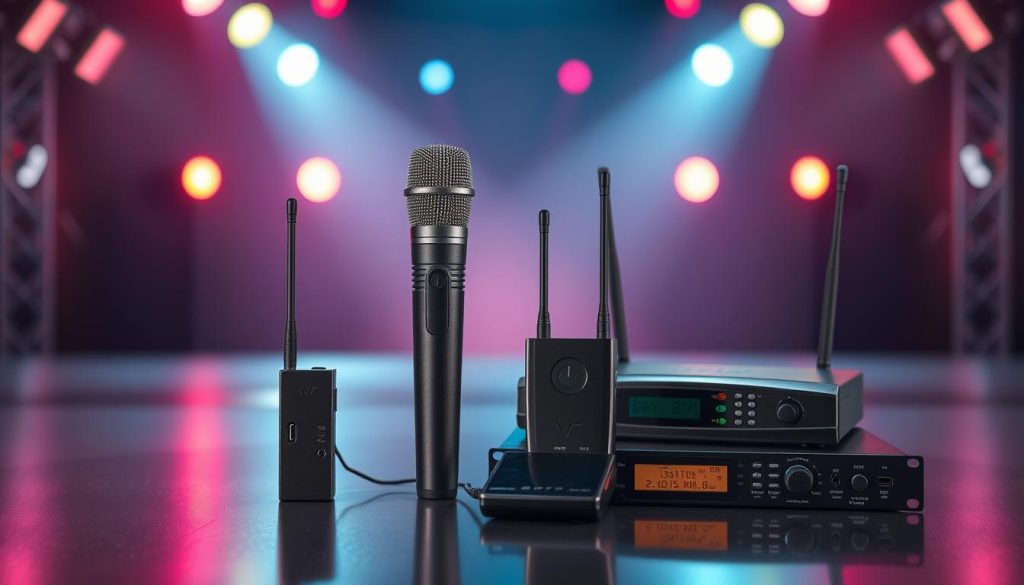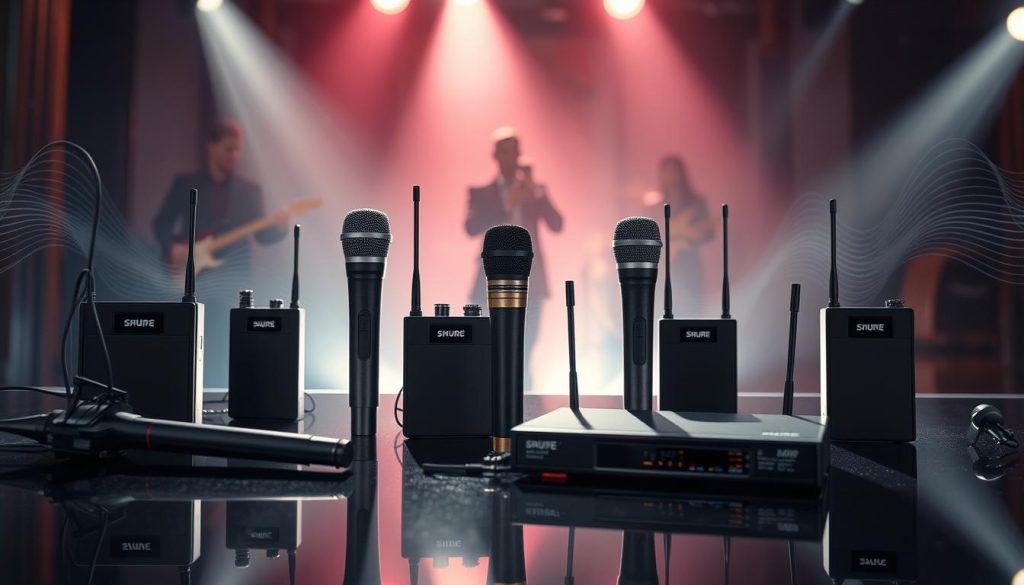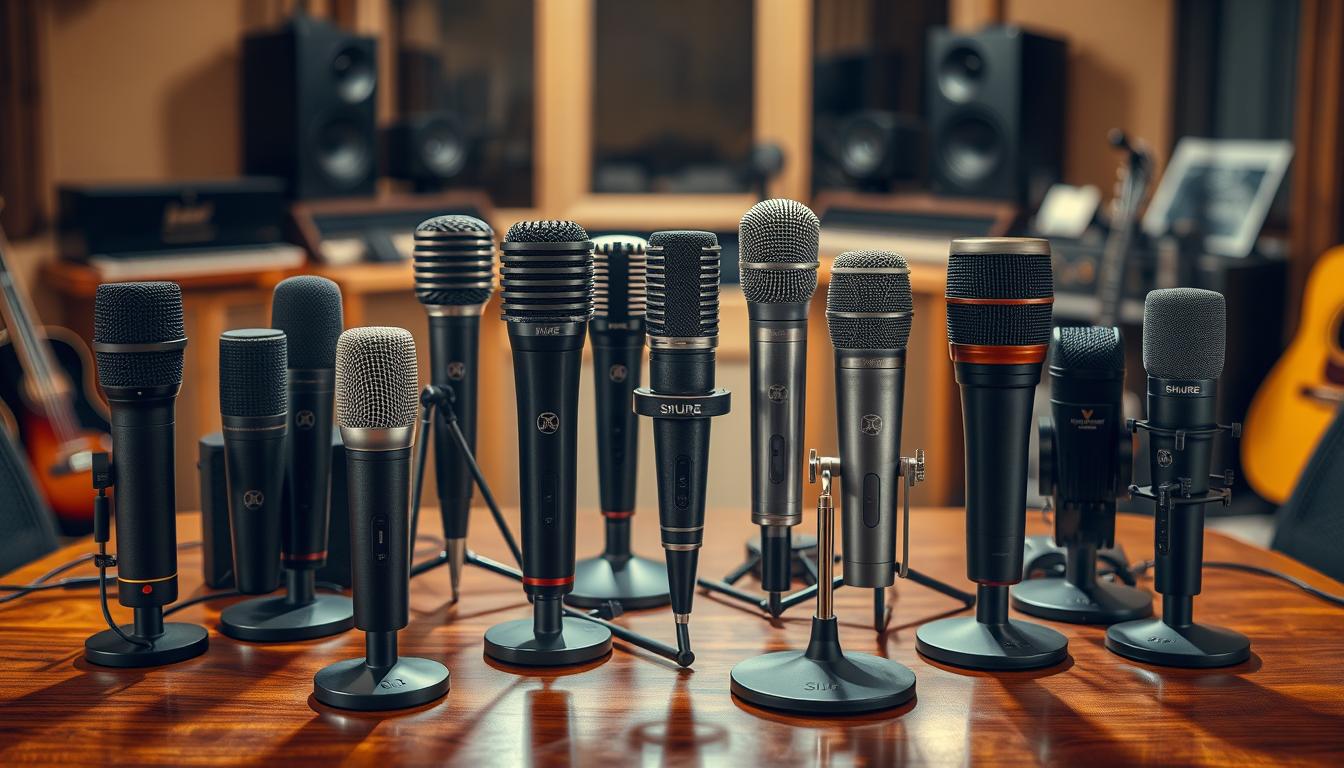I love the amazing sound and flexibility of Shure microphones. They’re great for anyone, from pros to beginners in audio. Shure’s top-quality microphones make sure you get the best sound for any event.
The famous SM58 and the KSM44A are just a few of Shure’s top products. They’re known for their amazing sound quality. Musicians, broadcasters, and audio experts worldwide trust Shure for their gear.
This article will cover Shure microphones and what to think about when choosing one. We’ll look at some of their best and most versatile options. Whether you’re in the studio, on stage, or recording for a presentation, Shure has a microphone for you.
Introduction to Shure Microphones
Shure is a top name in the audio world. They make high-quality microphones for recording, live shows, and more. It’s important to know what makes each Shure microphone right for you.
Shure: A Legacy of Excellence in Audio
Shure started in 1925 with Sidney N. Shure’s dream of quality audio gear. Over the years, they’ve led in innovation. They’ve made famous mics like the SM58 and modern digital wireless ones.
This has made Shure a trusted name in audio.
Choosing the Right Microphone for Your Needs
- Identify the sound source: Are you recording vocals, instruments, or presentations?
- Consider the performance environment: Will the microphone be used in a studio, on a live stage, or for broadcast purposes?
- Understand the different microphone technologies: Dynamic, condenser, and wireless options each have their own unique characteristics and applications.
- Prioritize factors like sound quality, durability, and connectivity to find the perfect Shure microphone for your specific needs.
Exploring Shure’s history and microphone options helps you pick the best gear. This can improve your recording, live shows, or broadcasts.
Factors to Consider in Microphone Selection
Choosing the right microphone is key. Think about the sound source and the place you’ll be using it. This helps you pick the best microphone for recording vocals, instruments, or presentations.
Sound Source: Vocals, Instruments, or Presentations
For vocals, handheld, headset, and lavalier microphones are great for live shows. They let you move around without losing sound quality. In studios, condenser microphones are top picks for their detailed sound.
For instruments, the choice gets more specific. Dynamic microphones work well for loud sounds like drums and guitars. Condenser microphones are perfect for capturing the fine details of acoustic instruments.
For presentations, you might use both vocal and instrument microphones. Lavalier or headset mics offer freedom of movement. Larger mics are good for podiums.
Performance Environment: Studio, Live, or Broadcast
The place you’re performing in affects your microphone choice. In studios, omnidirectional mics capture a natural sound. But in live shows, cardioid mics focus on the sound source to cut down on feedback.
In broadcasting, like news or radio, you need microphones that reject noise and sound consistent. Special broadcast mics with supercardioid or hypercardioid patterns work well here.
Knowing about the sound source and setting helps you pick the right microphone. This ensures your audio quality is top-notch and meets your creative goals.
Types of Microphone Capsules
Choosing the right microphone capsule is key in microphone technology. There are three main types: dynamic, condenser, and ribbon. Each has its own strengths for different uses.
Dynamic Microphones: Durable and Warm
Dynamic microphones are tough and give a warm sound. They use a moving coil and diaphragm to turn sound into electrical signals. This makes them great for live shows and loud places.
They are often chosen by singers, musicians, and speakers who want a reliable sound.
Condenser Microphones: Detailed and Sensitive
Condenser microphones have a clear and detailed sound. They use a thin, charged diaphragm to catch sound waves. This gives them a sensitive and precise sound.
They are often used in studios for recording vocals and acoustic instruments. They capture sound with a lot of detail.
Ribbon microphones are not as common in live shows because they are fragile. But, they are loved for their ability to capture high notes without being too harsh. They use a thin ribbon to turn sound into electrical signals.
This gives a smooth and natural sound. Audio engineers and musicians who want the best sound often choose them.
The choice between dynamic, condenser, and ribbon microphones depends on what you need for your project or performance. Think about the sound you want and the environment you’re in. This will help you pick the right microphone capsule.
Wireless Microphone Systems

Wireless microphone systems are now a big deal in audio tech. They offer more freedom and a cleaner look on stage. These systems have changed how we capture and send sound. It’s key to know the differences between analog and digital wireless tech, and the frequency bands they use.
Analog vs. Digital Wireless Microphones
Analog wireless mics have been around for a while and are still reliable and affordable. But, digital wireless tech has brought new sound quality and signal stability. Digital mics use special tech to make the sound clear and consistent, making them great for pros.
Frequency Bands: VHF, UHF, and 2.4GHz
Choosing the right frequency band is important for wireless mics. VHF and UHF are classic choices, offering many frequencies for devices. The 2.4GHz band is newer and offers a stable, clear signal with less interference.
| Frequency Band | Advantages | Disadvantages |
|---|---|---|
| VHF |
|
|
| UHF |
|
|
| 2.4GHz |
|
|
When picking a wireless mic system, think about what you need for your event, the sound quality you want, and the local wireless rules. Knowing the differences between analog and digital, and the good and bad of each frequency band, helps you choose the best system. This ensures your mics give you great sound and reliability.
Shure Microphones: Quality Sound for Every Occasion
Shure microphones are a top choice for great audio quality. They work well for many uses, from live shows to recording in the studio. These microphones make sure your voice or music sounds clear and sharp.
If you’re a musician, speaker, or audio pro, Shure has a microphone for you. They offer a wide range of products for different needs. This includes live shows, recording studios, video making, and podcasting.
Shure is all about innovation and quality. They put a lot of work into making their microphones durable and reliable. This means you can count on them to perform well, even in tough conditions.
Shure’s lineup includes everything from the famous SM58 to the latest wireless systems. No matter where you are – in the studio, on stage, or giving a presentation – Shure microphones will make sure your sound is top-notch. Your audience will love the quality.
Check out Shure’s wide selection of microphones to find the right one for you. With Shure, you can improve your sound and make a big impact, wherever you go.
Shure Wireless Microphone Systems

Shure is a top name in audio tech. They have wireless microphone systems for all kinds of users. These systems work great in small places or big events. Let’s look at the BLX and GLX-D+ Dual Band systems.
BLX: Professional Sound for Small Venues
The BLX system is perfect for small places like schools or local events. It’s easy to use and gives great sound. You don’t need to know a lot about tech to use it.
It’s plug-and-play, so you just turn it on and go. It picks the best frequency on its own. This makes it great for beginners in wireless mics.
GLX-D+ Dual Band: Automatic Frequency Management
For those who need more from their mics, Shure has the GLX-D+ Dual Band. It switches between two frequencies to avoid interference. This is great for musicians or professionals who need reliable sound.
It has many ways to connect and is easy to use. It’s perfect for anyone who wants a wireless mic that can grow with their needs.
| Feature | BLX | GLX-D+ Dual Band |
|---|---|---|
| Frequency Bands | UHF | 2.4GHz and 900MHz |
| Automatic Frequency Management | No | Yes |
| Connectivity Options | Basic | Versatile |
| Ideal for | Small Venues | Flexible Wireless Needs |
Advanced Shure Wireless Microphone Systems
Shure leads in audio tech with advanced wireless mics. They offer the SLX-D, QLX-D, and ULX-D for pro settings. These systems give top-notch audio quality and work well in tough places.
SLX-D: Crystal-Clear Digital Audio
The SLX-D wireless mic system gives you clear digital audio. It captures your voice or instrument clearly. It’s great for live shows, broadcasts, and important events because it has a strong, low-delay wireless link.
QLX-D: Efficient Spectrum Usage
The QLX-D system uses spectrum wisely, letting many systems work together without interference. This means more wireless channels for big events, conferences, and setups across rooms.
ULX-D: Dante Digital Audio Networking
The ULX-D system works with Dante digital audio networking. It makes setting up complex audio easy. It connects with many pro audio devices, making big audio systems simpler to manage.
Shure’s wireless mics, like the SLX-D, QLX-D, and ULX-D, offer great audio, save spectrum, and work with digital networks. They’re perfect for live sound engineers, broadcast pros, or event planners. These systems help you reach the highest audio quality.
Axient Digital: Flagship Wireless System
The Axient Digital system is the top choice for Shure’s wireless microphones. It’s made for the best broadcasts and live events. It has advanced features that make it the best in wireless tech.
This system is known for its amazing sound and quick response. It ensures smooth audio for professional uses. It also has a Spectrum Manager that finds and avoids interference, so you can work in tough RF areas.
Axient Digital offers many ways to send digital audio, including Dante networking. It’s perfect for big live events or important broadcasts. It gives you the quality, reliability, and flexibility pros need.

